Making Fermented Pickles
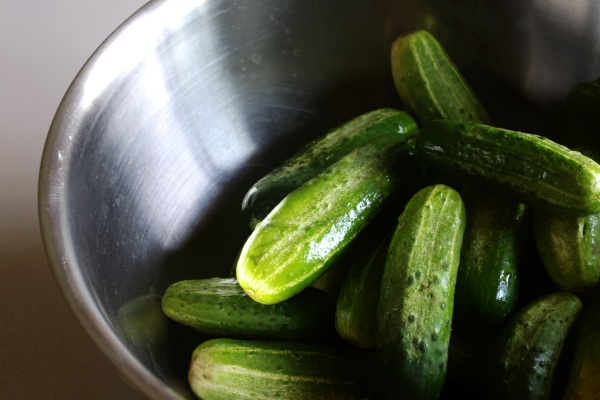
A few people have asked me exactly how I make my lacto-fermented pickles. I haven’t really shared a recipe because I don’t actually use one. I use a method instead.
You see, when I first started making ferments I was totally obsessed with exact recipes. I was still in the pasteurized mentality and the thought of leaving things out at room temperature to actually improve the health of the food went against everything I had ever been taught.
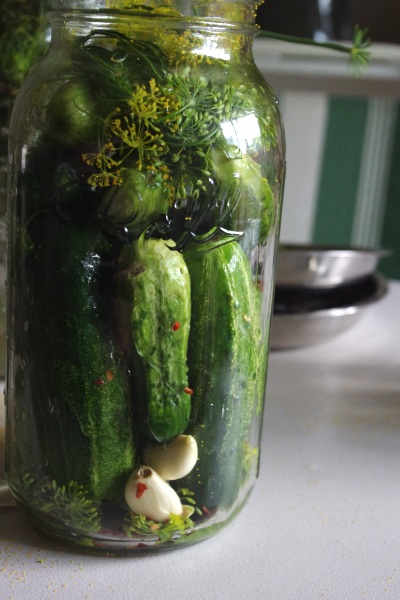
But as I’ve experimented more over the last five years I have learned that no two ferments are alike, which is part of the beauty of it, and that as long as you understand the method you can ferment just about anything.
We have really come to enjoy these pickles and the help that they are to our digestion.
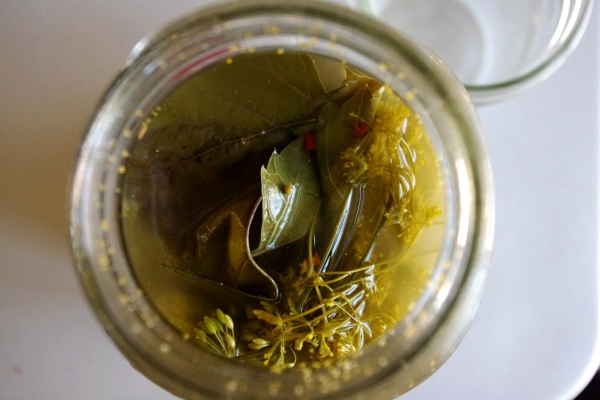
Here is my method:
Make a brine from 5 tablespoons of fine-grained sea salt and two quarts of hot water. Allow to cool before using.
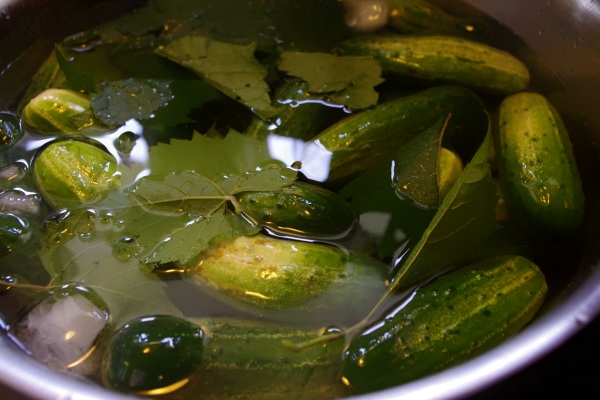
Meanwhile wash your cucumbers and grape leaves really well and allow to soak in some cold water.
At the bottom of a 1/2 gallon jar add a generous amount of dill, two grape leaves, a few cloves of peeled garlic, and a sprinkle of red pepper flakes.
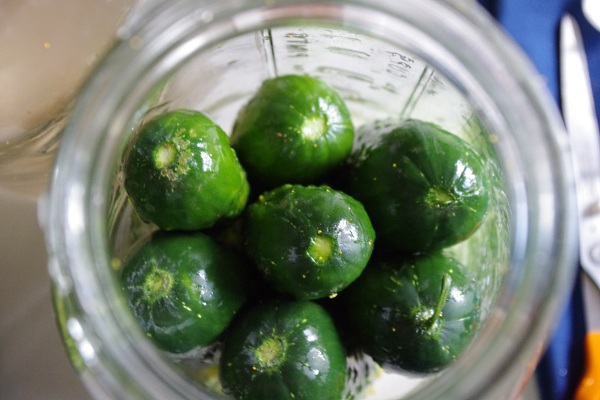
Start packing the largest cucumbers vertically in the bottom half of the jar so that they fit tightly. Add another layer of dill, grape leaves, garlic, and spices.
Layer in the smaller cucumbers horizontally or vertically, however you can best pack them in tight, leaving a good 1 1/2 – 2 inches of head space. Add one more layer of dill and red pepper flakes.
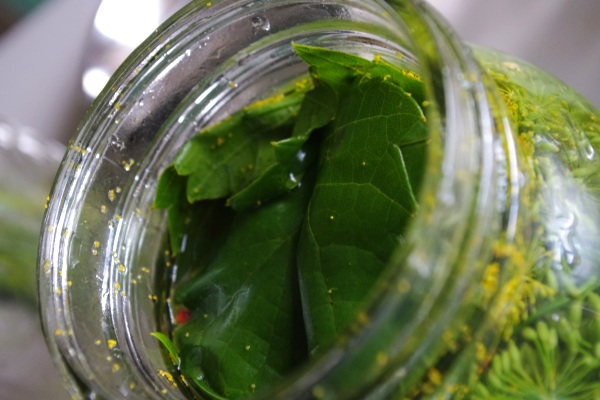
Pour the brine over the cucumbers until completely covered. Place a grape leaf over top of the cucumbers and dill so that it keeps them under the brine level. Make sure there is at least an inch between the brine and the top of the jar.
Place the jar lid on tightly and leave at room temperature for 3-5 days, depending on the temperature. When it is really warm (80+) I find that three days is enough. If it is cooler I like to leave them for another day or two, or until the brine is bubbly and cloudy.
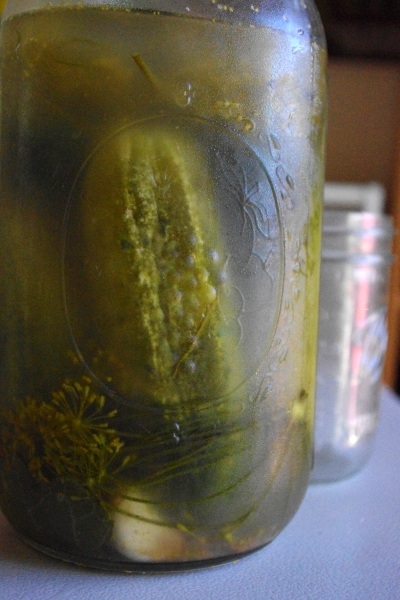
During this time I also like to "burp" the jars every day to release some of the pressure. We have had a jar crack and explode on us in the middle of the night and had to throw away the pickles.
Place in the refrigerator or other cold storage facility. Eat them right away or leave them to age which will produce an even better flavor and you can enjoy them in the dead of winter.
So that’s how I’ve been making our pickles.
Do you have a different method you can share?


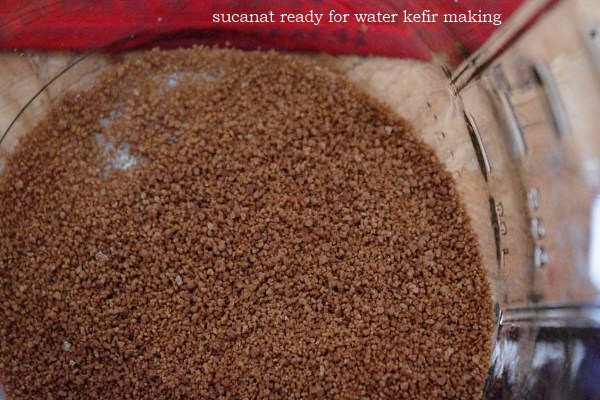
make mine in a crock. Use pin cherry leaves, a plate on top to hold them down. Leave them for about 3 weeks, removing scum every day. When they are ready, I pack them into jars, sliced, whole or quartered, strain the liquid, boil it for 5 minutes, pour it over the pickles, seal the jars. Sometimes add grape leaves. They are crunchy and will last a year or two
I just tried my first batch of fermented pickles. They turned out delicious, but the garlic cloves (and only the garlic) have started molding. At least I think its mold. They are kinda bluish in color. Is that ok? Should I dump the batch?
This is a super old comment but bluing garlic is fine
I made three jars of small cucumbers from the farmers market following your method carefully and they came out fantastic!. I’m going to put them in the fridge tomorrow. How long will they stay good for?
Thank you so much for this. I’ve been making these for about a month and can’t seem to keep them around for longer than a week or so.
Thanks – beautiful!
I’m hoping you can answer a question (actually 2 questions): Regarding pickles cucumbers, does using lower salt brine such as 3% vs 5% and aging longer at higher salt brine make a difference to final outcome? For example, using 3% and fermenting 2 weeks vs using 5% and fermenting 4 weeks end up with the same result or different result? The second question, kind or related: fermentation done once the CO2 bubbles stop rising? Is there any benefit to aging in brine longer than that or is it done changing once the fermentation has stopped?
Traditional canning information suggests that blue or green-tinted garlic is caused by iron, tin or aluminum in the water which reacts to the garlic pigments, or as a result of soil minerals which become accentuated during fermentation. … Some amino acids may react with sulphur, causing blue or green discoloration.
This looks like a great method. Are the grape leaves included to keep the pickles crunchy? I’ve heard that adding grape leaves or some sort of similar leave will keep the pickles crunchy because of the tannins in the leaves. Thanks for sharing your method!
Billy – Yes, leaves with tannins help with crunch.
Hi, I’m new to fermenting, although, I’ve gotten really good at saurkraut! I also live in Malaysia and getting grape leaves is next to impossible. Is there another leaf you recommend? I read that sweet potato leaves have tannins? also mango leaves? I live on an island and would kill for a good Jewish pickle!
Thank you in advance
Gabrielle – What a “pickle” you are in. 😉
I do not know if sweet potato or mango leaves would work. How about horseradish or even regular tea leaves (like black tea)?
Bay leaves have worked well for me rather than hard to find grape leaves.
Great recipe thank you. Just finished making my first jar. I’m excited to try them.